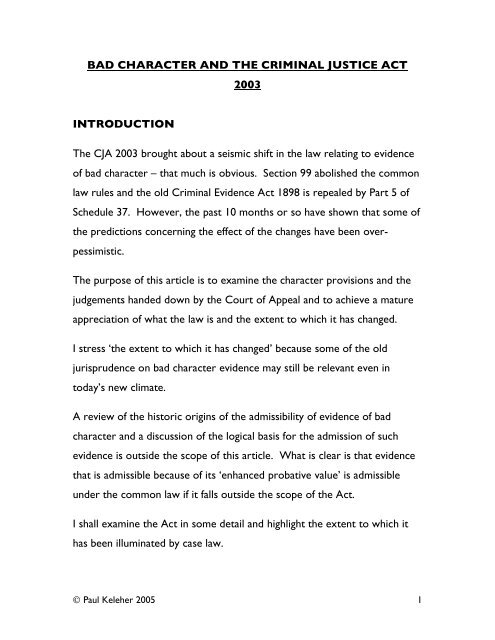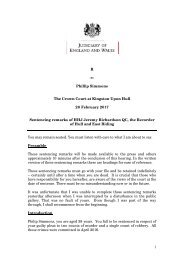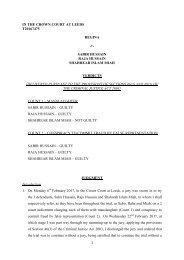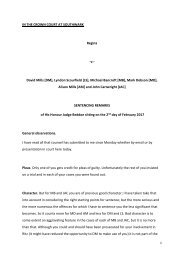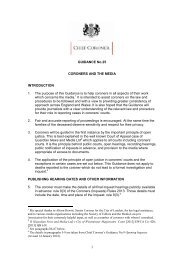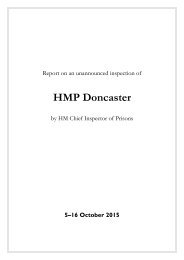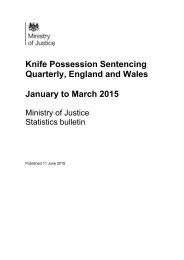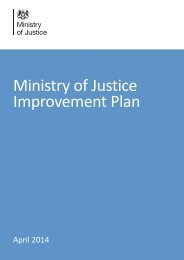bad-character-lecture-2-extended
bad-character-lecture-2-extended
bad-character-lecture-2-extended
Create successful ePaper yourself
Turn your PDF publications into a flip-book with our unique Google optimized e-Paper software.
BAD CHARACTER AND THE CRIMINAL JUSTICE ACT2003INTRODUCTIONThe CJA 2003 brought about a seismic shift in the law relating to evidenceof <strong>bad</strong> <strong>character</strong> – that much is obvious. Section 99 abolished the commonlaw rules and the old Criminal Evidence Act 1898 is repealed by Part 5 ofSchedule 37. However, the past 10 months or so have shown that some ofthe predictions concerning the effect of the changes have been overpessimistic.The purpose of this article is to examine the <strong>character</strong> provisions and thejudgements handed down by the Court of Appeal and to achieve a matureappreciation of what the law is and the extent to which it has changed.I stress ‘the extent to which it has changed’ because some of the oldjurisprudence on <strong>bad</strong> <strong>character</strong> evidence may still be relevant even intoday’s new climate.A review of the historic origins of the admissibility of evidence of <strong>bad</strong><strong>character</strong> and a discussion of the logical basis for the admission of suchevidence is outside the scope of this article. What is clear is that evidencethat is admissible because of its ‘enhanced probative value’ is admissibleunder the common law if it falls outside the scope of the Act.I shall examine the Act in some detail and highlight the extent to which ithas been illuminated by case law.© Paul Keleher 2005 1
Some of those sections are looked at in less detail if they are selfexplanatoryor because there is no new authority on the point.WHAT IS BAD CHARACTER?Section 98 defines what is meant by <strong>bad</strong> <strong>character</strong> under these provisions.The definition is not limited to previous convictions: it covers any evidenceof “misconduct” or “a disposition towards misconduct”.Section 112 defines ‘misconduct’ and says it “means the commission of anoffence or other reprehensible behaviour”.It is important to note that there are two separate issues to consider here;firstly, is there material capable of amounting to evidence of misconduct,but secondly, can it be proved according to the usual rules of evidence?R v Weir & Others [2005] EWCA Crim 2866 is a case wheresomething other than the commission of an offence has been put inevidence. The Court pointed out that s.103(2) to which we shall come indue course, says a propensity to commit crime may be proved by evidenceof commission of other offences, but is not confined to that.This is also illustrated by the case of R v Renda [2005] EWCA Crim2826, but in the case of defendants, evidence of misconduct will usually belimited to evidence pertaining to previous convicitions.R v Weir is also a case where there has been any discussion of whetheragreed conduct following short of a conviction is or is not reprehensible,about which, more later© Paul Keleher 2005 2
I can not give a finite list of examples of what may be admissible and how itmay be proved; although one will usually be dealing with evidence ofconvictions, it is important to note that the Act places no such restrictionon the evidence that is admissible.PROCEDUREThis would be a convenient place to deal with the procedure to befollowed if it is anticipated that evidence of <strong>bad</strong> <strong>character</strong> may be adduced.The Act itself prescribes the requirement of notice in Section 111(2).Where the party in question is the prosecution and they propose toadduce evidence of a defendant's <strong>bad</strong> <strong>character</strong>, or to cross-examine awitness with a view to eliciting such evidence, notice must be served on thedefendant in the prescribed form.The rules are now part of the Criminal Procedure Rules and thosegoverning this aspect of the criminal process are contained in Part 35 ofthose Rules.The Rules set out the procedure requiring notice to be given of anintention to adduce evidence of <strong>bad</strong> <strong>character</strong> and the prescribed FormBC2 sets out the required content of the notice and BC3 the requiredcontent of any objections. 1The Rules state: -(i) notice of intention to adduce evidence of <strong>bad</strong> <strong>character</strong> must begiven on the prescribed form which requires: -1 If you Google ‘Criminal Justice Act 2003 BC2’ you will find a downloadable version of theform.© Paul Keleher 2005 3
(ii)(iii)(iv)(v)a. "a description of the <strong>bad</strong> <strong>character</strong> evidence and how it is tobe adduced or elicited in the proceedings including the namesof any relevant witnesses." 2in the case of a non-defendant’s <strong>bad</strong> <strong>character</strong>:a. it must be served on all parties and the court not more than14 days after the prosecutor has purported to make primarydisclosure, or as soon as reasonably practicable where theapplication relates to a defence witness [in other words, whenthe existence of this witness is known about]b. opposition to the application must give notice of oppositionwithin 14 days of receiving applicationin the case of a defendant’s <strong>bad</strong> <strong>character</strong> to be adduced by theprosecution:a. it must be served on all parties not more than 14 days aftercommittal or service of evidence in cases of s.51 transfer orservice of notice of transfer to the Crown Court in casesunder s.4 of the Criminal Justice Act 1988 or s.53 of theCriminal Justice Act 1991in the case of a defendant’s <strong>bad</strong> <strong>character</strong> to be adduced by a codefendant:a. not more than 14 days after the prosecutor has purported tomake primary disclosurenotice of application to exclude <strong>bad</strong> <strong>character</strong> evidence must beserved on all parties on the correct form within 7 days of receiptof the notice.2 The form of application (BC2), prescribed by Rule 23E, inserted into the Crown Court Rules1982 by Statutory Instrument 2004 No 2991 (L18)© Paul Keleher 2005 4
The crucial points to note are the time limits and that the notice mustcontain a description of the <strong>bad</strong> <strong>character</strong> evidence and how it is to beadduced or elicited in the proceedings including the names of any relevantwitnesses.Rule 35.8 enables the court to allow a notice or application in a differentform or orally and shorten or extend any time limit.I suspect the time limits will be treated as pretty flexible; what is moreimportant is the content of the notice.The Court in R v Hanson, Gilmore and Pickstone [2005] EWCACrim 824 recognised the practical problems that would result if the ruleswere not followed: -“We would expect the relevant circumstances of previous convictionsgenerally to be capable of agreement, and that, subject to the trial judge'sruling as to admissibility, they will be put before the jury by way ofadmission. Even where the circumstances are genuinely in dispute, wewould expect the minimum indisputable facts to be thus admitted. It will bevery rare indeed for it to be necessary for the judge to hear evidence beforeruling on admissibility under this Act.” 3This may be true of the fact of a conviction, but when it comes to anyadditional material that the prosecution seek to rely upon the position isvery different. Remember the notice must specify “a description of the <strong>bad</strong><strong>character</strong> evidence and how it is to be adduced or elicited in theproceedings including the names of any relevant witnesses." This was3 Paragraph 17© Paul Keleher 2005 5
epeated in R v Bovell and Dowds [2005] EWCA Crim 1091when Rose LJ explained why it was so important: -“First, it is necessary for all parties to have the appropriate information inrelation to convictions and other evidence of <strong>bad</strong> <strong>character</strong>, whether inrelation to the defendant or to some other person, in good time. That canonly be achieved if the rules in relation to the giving of notice are compliedwith.”“It is worth mentioning that the basis of plea in relation to an earlierconviction may be relevant where it demonstrates differences from the wayin which the prosecution initially put the case. In other words, a merereference to the statement of a complainant in an earlier case may notprovide the later court with the material needed to make a decision as to theadmissibility of the earlier conviction.” 4There have been cases where real injustice flowed from a failure to giveproper notice. The judgement in R v Edwards, Fysh Duggan &Chohan [2005] EWCA Crim 1813 makes it clear the prosecutionshould not embark upon speculative cross-examination where inadequatenotice makes it impossible to properly establish the facts of a conviction.“the facts were not agreed because no notice had been given and noadequate pre-trial enquiries had, in consequence, been made. Thedefendant was cross-examined about the facts of one of these offences. MrLynn submits the defendant was embarrassed in consequence, because theexplanation which he had to give in relation to one of the offences was that it4 Paragraph 2© Paul Keleher 2005 6
did not involve entry into someone else's home, and the victim of the offencewas his girlfriend. Clearly, it is unfortunate that there was crossexaminationin those circumstances.As this Court has previously pointed out, (see Bovell & Dowds para 2) it isimportant that provisions in relation to notice are observed so that adequateenquiries can be made on both sides as to the circumstances of offences, inso far as those circumstances may be relevant when the question of theadmissibility of previous convictions arises.” 5Finally on this subject the case of R v Humphris [2005] EWCA Crim2030 is the clearest example yet of the need to both give proper noticeand abide by the rules of evidence. In that case the prosecution sought notonly to prove previous convictions as evidence of propensity, but to relyupon s.117 of the Criminal Justice Act 2003 to adduce evidence from apolice officer of what she had read on the Police National Computerregarding the method employed by the defendant in those earlier crimes.The Court firmly squashed this proposition. The hearsay evidence couldnot be given because the person who made the written statement [thepolice officer] did not have personal knowledge of the matters contained init. A statement would have had to be taken from the original complainant,and that would not be admissible unless one of the provisions justifyingreading it were satisfied.One point to remember, the mere production of a certificate of convictionis not enough. Under s.73 Police and Criminal Evidence Act 1984 the5 Paragraphs 31-32© Paul Keleher 2005 7
prosecution also have to prove that the defendant is the person named inthe certificate. 6The sum of the effect of these judgements is that rarely will evidence of thefacts of a previous case be admissible unless the prosecution have takensteps to secure the attendance of the witnesses from that earlier case, orthe defendant is prepared to make a generous admission.These authorities are powerful examples of the need to ensure that theprosecution do not skimp on their duties to give proper notice at theproper time.It is not yet obligatory to give notice of an intention to call a defencewitness, but if they have <strong>bad</strong> <strong>character</strong> one may be criticized for failing todo so. If it is an inevitable consequence of calling that witness that theprosecution would be entitled to an adjournment to research their<strong>character</strong> it would seem to be at least arguable that a failure to give suchnotice will result in wasted time and costs.It is also worth noting that the usual rules as to disclosure must apply –something of which the prosecuting authorities seem to be unaware.Because <strong>bad</strong> <strong>character</strong> is now part of the prosecution case, rather thansomething to be potentially deployed in cross-examination, the prosecutorhas all the usual duties of proper inquiry to ensure that any material capableof undermining the effect of the evidence is disclosed. This includes forexample written bases of plea submitted in earlier cases, any evidence inthe earlier case of any degree of provocation or aggression by victims of6 West Yorkshire Probation Board v Boulter [2005] EWHC 2342 (Admin) is a helpful guide tothe resolution of this issue© Paul Keleher 2005 8
violence, material suggesting a former co-defendant may have beenprimarily responsible for the offence, evidence that the defendant had beendrunk or otherwise intoxicated when committing the earlier offence and soon. It may seem onerous to place this burden of investigation on theprosecution, but if they seek to adduce the evidence as evidence ofpropensity, they have a duty to investigate the extent to which it isevidence of such.If therefore the prosecution give notice of intention to adduce evidence of<strong>bad</strong> <strong>character</strong> it may be necessary to: -(1) object in the BC3 to admission of the evidence in anything otherthan an admissible form;(2) remind the Court and prosecution of their normal duties of primarydisclosure;(3) object in the BC3 on the grounds of non-disclosureNON-DEFENDANT’S BAD CHARACTERSection 100 deals with non-defendant’s <strong>bad</strong> <strong>character</strong>; this may be aprosecution witness, a defence witness or someone who is not a witness atall – such as the deceased in a murder trial or indeed anyone who featuresin the facts of the case.I do not propose to spend much time on deconstructing these conditionsother than to note: the use, sometimes repeated, of the words important,substantial, difficult and impossible; and please note the fairly restrictivenature of the conditions precedent to allowing cross examination of a© Paul Keleher 2005 9
witness.Non-defendants may now be cross examined as to <strong>character</strong> if , and only if© Paul Keleher 2005 10
(1) (a) it is important explanatory evidence,(b) it has substantial probative value in relation to a matter which -(i) is a matter in issue in the proceedings, and(ii) is of substantial importance in the context of the case as awhole, or(c) all parties to the proceedings agree to the evidence beingadmissible.Evidence is important explanatory evidence if -(2) (a) without it, the court or jury would find it impossible or difficultproperly to understand other evidence in the case, and(b) its value for understanding the case as a whole is substantial.(3) In assessing the probative value of evidence for the purposes ofsubsection (1)(b) the court must have regard to the following factors (and toany others it considers relevant) -(a) the nature and number of the events, or other things, to which theevidence relates;(b) when those events or things are alleged to have happened orexisted;(c) where -(i) the evidence is evidence of a person's misconduct, and© Paul Keleher 2005 11
(ii) it is suggested that the evidence has probative value byreason of similarity between that misconduct and other allegedmisconduct, the nature and extent of the similarities and thedissimilarities between each of the alleged instances ofmisconduct;Finally, and perhaps most importantly of all, s.100(4) states that suchevidence can only be given with the leave of the court.The Court in R v Bovell and Dowd considered submissions from theCrown on this issue - the extent to which the witness’s misconductqualified - but unfortunately were not required to come to any conclusionsas to the extent or operation of these restrictions. They did approve thetrial judge’s conclusion that a prosecution witnesses convictions wereunimportant.In R v Weir and Others, in the appeal of Hong and De the Courtmade the unsurprising finding that a person’s arrest for an offence is notevidence of misconduct.If there was any doubt that Parliament intended a non-defendant to enjoygreater protection than defendants, in the appeal of Somanathan in theCourt said this: -“Paragraph 363 of the Explanatory Notes does refer to ‘an enhanced relevancetest’ 7 but only in relation to section 100 of the Act. The terms of that sectionclearly impose a higher test in respect of the introduction of a non-defendant’s7 a reference to O’Brien v Chief Constable of South Wales Police [2005] 2 WLR 1038© Paul Keleher 2005 12
ad <strong>character</strong> than the test for the introduction of a defendant’s <strong>bad</strong> <strong>character</strong>.” 8No doubt this provision in the Act was intended to prevent defendantsmaking a meal of a prosecution witness’s <strong>character</strong> where either thatwitness or their previous convictions were of peripheral importance. Butthese restrictions apply equally to defence witnessesIn the appeal of Yaxley-Lennon in the case of R v Weir and Othersthe Court agreed that a defence witness’s caution for possession ofcocaine was inadmissible under s.100(1). The witness was crucial, but thecaution did not have substantial probative value in relation to hercredibility. 9DEFENDANT’S BAD CHARACTERSection 101 is the best known section in this part of the Act and deals withthe defendant’s <strong>bad</strong> <strong>character</strong>.It contains in subsetion (1) the so-called seven gateways by which evidencemay be admitted;8 Paragraph 369 Paragraph 73-74© Paul Keleher 2005 13
(a) all parties to the proceedings agree to the evidence beingadmissible,(b) the evidence is adduced by the defendant himself or is given inanswer to a question asked by him in cross-examination andintended to elicit it,(c) it is important explanatory evidence,(d) it is relevant to an important matter in issue between thedefendant and the prosecution,(e) it has substantial probative value in relation to an importantmatter in issue between the defendant and a co-defendant,(f) it is evidence to correct a false impression given by thedefendant, or(g) the defendant has made an attack on another person's<strong>character</strong>.The remaining sections of the Act firstly explain, elucidate or define themore novel or difficult gateways and secondly incorporate certainsafeguards for the defendant. I will therefore attempt to deal with first withthe parts that explain and secondly with the various provisos.Some of the gateways are self-explanatory but subsequent sections aresupposed to help us appreciate how other gateways actually open.I shall try to deal with each gateway in turn and, in relation to each, refer tothe subsequent sections insofar as they provide further explanation.© Paul Keleher 2005 14
After that I shall return and then consider the provisos. If decided casesprovide examples of the gateways in operation I shall cite them forillustrative purposes.Subsections (a) and (b) are self-explanatory(c) it is important explanatory evidence,Further light is shed upon (c) by section 102; evidence is importantexplanatory evidence if -(a) without it, the court or jury would find it impossible or difficult properlyto understand other evidence in the case, and(b) its value for understanding the case as a whole is substantialAn illustration of the operation of this subsection is provided by R vEdwards, Fysh, Duggan & Chohan [2005] EWCA Crim 1813.The Court considered the case of Mr Chohan who was accused of robberyand firearms offences. He had robbed an elderly householder and as he ranoff was recognized by Ms Donna Marsh. She made a statement to thepolice saying she recognized him from seeing him in pubs in the area. Latershe made a another statement admitting that she bought heroin from himregularly and had seen him every other day or so for at least a year.Her evidence that he was a heroin dealer was admitted under s.101(1)(c)on the following basis: -“it was inevitable that the jury, who would have to be directed as to thecaution necessary in identification by reference to Turnbull, would have toconsider the circumstances in which the witness claimed to be able toidentify the defendant. It would, the judge concluded, be difficult properly© Paul Keleher 2005 15
to understand other evidence in the case without knowing the backgroundof the heroin dealings which, he concluded, went to the heart of matters.” 10(d) the evidence is relevant to an important matterin issue between the defendant and the prosecutionThis section has attracted most attention because of the new concept thatmatters in issue include a propensity to commit offences and/or beuntruthful , but before we turn to that there are some other importantpoints to note.The matter in issue must be an important one. There is already oneauthority on the meaning of this provision which should serve as a warningto prosecutors who think the new law gives them an easier ride than thecommon law did when it comes to adducing evidence of <strong>bad</strong> <strong>character</strong> on a‘matter in issue’ other than mere propensity.The appeals of R v Highton, Van Nguyen and Carp [2005]EWCA Crim 1985 are mainly important for other reasons that I shallcome to shortly, but the case of Van Nguyen is relevant to the point we areconsidering now,Nguyen went to the police to report being robbed of £10 in a publiclavatory. They then visited him and discovered that he lived with hisbrother in a house where cannabis was being grown on an industrial scale;he was charged, together with his brother, with cultivating it. His brotherpleaded guilty, and there was no evidence against Nguyen apart from the10 Paragraph 70© Paul Keleher 2005 16
fact he lived there. He admitted knowing what the plants were but simplydenied being involved in their cultivationIn interview he admitted that he was a heroin addict. His counsel sought toexclude this evidence as being irrelevant. Prosecution persuaded the courtthat the evidence be admitted under s.101(1)(d) because it showed thedefendant was conversant with the drugs scene and therefore more likelyto know what the plants were.The prosecution went further and adduced evidence of the defendant’s 4convictions for shoplifting under s.101(1)(d) on the basis that they werecarried out to fund his heroin addiction. The defendant was then crossexaminedto the effect that his connections with his own heroin dealerswould give him ready access to persons who could sell the cannabis crop.To cap it all, the prosecution’s coup de grace was to suggest that when hewas robbed he must have been trying to buy heroin and being the sort ofperson to buy heroin in pub lavatories his dealer could be the actual sellerof the cannabis that was being grown.Mr Van Nguyen’s conviction at the hands of this highly imaginative, not tosay creative, prosecutor was quashed. The Court ruled that whether ornot Mr Van Nguyen knew what the plants were – and he never said hedidn’t – this was not an important matter in issue, and therefore theevidence of his heroin addiction was not relevant to an important matter inissue as required by the section.Although s.99 abolishes the old common law rules on what is still looselycalled ‘similar fact’ evidence in respect of <strong>bad</strong> <strong>character</strong> evidence. Evidencethat is prejudicial but not necessarily evidence of misconduct is still© Paul Keleher 2005 17
admissible under the enhanced relevance’ basis as described in O’Neill(Respondent) v Chief Constable of South Wales Police(Appellant) [2005] UKHL 26, the latest bite at the ‘similar factcherry. So we now have a two tier system. Evidence of a propensity whichis not actually <strong>bad</strong> <strong>character</strong> is governed by the common law, evidence ofpropensity which is <strong>bad</strong> <strong>character</strong> is governed by the Act.What is and isn’t ‘reprehensible’? In the case of Manister, one of theappellants in Weir & Others, the appellant was charged with 3 sexualassaults on a girl of 13: he was 39.The judge admitted evidence that the defendant had previously had a sexualrelationship with a girl of 16 when he was 34 on the ground that it wasevidence of misconduct – ie reprehensible – and showed a propensity tomisconduct – ie being attracted to young girls. He also ruled that evidencethat the appellant had made a suggestive comment to the complainant’ssister implying that he fancied her was also admissible on the same basis.The Court of Appeal said both rulings were incorrect; a lawful sexualrelationship of this sort could not per se be described as reprehensible, norcould finding 15 year old girls attractive.However, because neither were evidence of <strong>bad</strong> <strong>character</strong>, the simplecommon law rules applied and none of the protection of the Act did notapply; both were admissible as evidence relevant to the question ofwhether the defendant could have a sexual interest in the complainant –even though she was only 13.© Paul Keleher 2005 18
Section 101(1)(d) is without doubt the most contentious of the gateways,but primarily because of the subsequent gloss upon ‘matter in issue’ towhich I’ve already referred and which is contained in section 103(1).s.103(1) states that, for the purposes of section 101(1)(d), the matters inissue between the defendant and the prosecution include -(a) the question whether the defendant has a propensity to commit offencesof the kind with which he is charged, except where his having such apropensity makes it no more likely that he is guilty of the offence;(b) the question whether the defendant has a propensity to be untruthful,except where it is not suggested that the defendant's case is untruthful in anyrespect.So please note, matters in issue include but are not restricted topropensity.s.103(2) states that: -where subsection (1)(a) applies, a defendant's propensity to commitoffences of the kind with which he is charged may (without prejudice to anyother way of doing so) be established by evidence that he has been convictedof-(a) an offence of the same description as the one with which he is charged, or(a) an offence of the same category as the one with which he is charged.I’ve already dealt with the practical problems of proving not only the factsof an alleged previous conviction, but even the conviction itself.The term ‘category’ refers to the power granted by s.103(4)(b) to theSecretary of State to draw up lists of offences in the same category.© Paul Keleher 2005 19
So we should consider the important issues of propensity to commitoffences of the kind charged, and propensity to be untruthful.R v Hanson, Gilmore & Pickstone [2005] EWCA Crim 824 laiddown some important ground rules on these issues. True to my scheme offurther defining the terms first, before turning to the provisos andprotections, I shall confine myself at this juncture to the points of definitionor elucidation. The court made the following points: -1. Does the history of convictions [the case confined itself to evidenceof misconduct arising from convictions] establish a propensity to commitoffences of the kind charged? 112. Does that propensity make it more likely that the defendantcommitted the offence charged? 123. There is no minimum number of events necessary to demonstratesuch a propensity. The fewer the number of convictions the weaker islikely to be the evidence of propensity. A single conviction for an offenceof an unremarkable nature is unlikely to establish propensity. 13 A singleprevious conviction for an offence of the same description or category maybe admissible if it shows a tendency to unusual behaviour or where itscircumstances demonstrate probative force in relation to the offencecharged (compare DPP v P [1991] 2 AC 447 at 460E to 461A) - referenceof course to the common law rules on ‘similar fact’.11 Paragraph 712 ditto13 Paragraph 9© Paul Keleher 2005 20
5. The sentence passed will not normally be probative or admissible atthe behest of the Crown, though it may be at the behest of the defence. 146. Propensity to untruthfulness is not the same as propensity todishonesty. Previous convictions, whether for offences of dishonesty orotherwise, are therefore only likely to be capable of showing a propensityto be untruthful where either there was a plea of not guilty and thedefendant gave an account, on arrest, in interview, or in evidence, whichthe jury must have disbelieved, or the way in which the offence wascommitted shows a propensity for untruthfulness, for example, by themaking of false representations. 15I would just observe here that this ruling should have been anticipated.Quite apart from the glaringly obvious use of the word ‘untruthfulness’ inthe act rather than dishonesty, the government made clear during thepassage of the Act that this limitation was intended 16 and that Act’sExplanatory Notes set out this precise distinction. 17The Criminal Justice Act 2003 (Categories of Offences) Order 2004 SI2004 No. 3346 is the first effort by the Secretary of State to draw upcategories of offences and thus prescribe certain offences as being of thesame kind. Some care should be exercised in relying upon this simplecategorisation as determinative of the question whether the conviction foran offence in the same category as the offence charged shows a propensityto commit the kind of offence charged.14 Paragraph 1215 Paragraph 1316 Hansard HL Vol. 654 col.198817 Explanatory Notes, Note 393© Paul Keleher 2005 21
For example, convictions for crimes of ‘dishonesty’ are not necessarilyprobative evidence of a propensity to committing other crimes ofdishonesty. Despite the fact that they are in the same category in theOrder, the Court firmly stated that: -“convictions for handling and aggravated vehicle taking, although withinthe theft category, do not, in our judgment, show, without more pertinentinformation, propensity to burgle as indicted or to steal, to which theapplicant pleaded guilty.”And went on to say that a robbery conviction may be too prejudicial to beadmitted despite being evidence of a propensity to steal. 18I shall, as I promised, return later to other restrictions on the admission of<strong>bad</strong> <strong>character</strong> evidence under this, or any other, gateway.e) it has substantial probative value in relation to animportant matter in issue between the defendantand a co-defendantSection 104(1) states that evidence which is relevant to the questionwhether the defendant has a propensity to be untruthful is admissible onthat basis under section 101(1)(e) only if the nature or conduct of hisdefence is such as to undermine the co-defendant's defence.R v Weir and Others reminded us that the rules as to relevance arethe same, whoever is seeking to adduce the evidence, and evidence that18 Paragraph 27© Paul Keleher 2005 22
would be irrelevant if adduced by the prosecution is just as irrelevant in thehands of a co-defendant.This section reflects the old rule that one defendant could only adduceevidence of another co-defendant’s <strong>bad</strong> <strong>character</strong> where the nature orconduct of his defence was such as to undermine the co-defendant'sdefence. However, this section highlights what is, to my mind, a slightmystery. The distinction between lack of credibility on the basis of apropensity for untruthfulness, and lack of credibility on the basis of general<strong>bad</strong> <strong>character</strong>.Section 104(2) makes it clear that only evidence adduced by a co-defendant– either in chief or cross-examination is admissible under this section.(f) it is evidence to correct a false impression givenby the defendantThis covers an express or implied assertion which is apt to give the court afalse impression about the defendant.This too reflects an old common law rule. Section 105 clarifies and limitsthe operation of this subsection.1. Firstly, the false impression must relate to the defendant, and notsomething else – this is made clear by s.105(a)2. Secondly, the defendant is responsible for any assertion madeeither during the proceedings, or when interviewed, questionedor charged – and which is given in evidence© Paul Keleher 2005 23
3. The assertion could be made by any defence witness, or in crossexaminationin response to a question by the defendant whichwas intended or was likely to elicit itI shall limit myself to a couple of observations.In R v Bovell & Dowds, Dowds was convicted of burglary. He had twoprevious convictions for burglary. It is not entirely clear from the report,but it seems as though evidence of these convictions was not adducedunder s.101(d) – propensity. However, when giving evidence Dowds saidhis co-defendant – who had pleaded guilty – had committed a similaroffence the day before by kicking in the door and he, Dowds, had objectedand stormed off. The Court agreed with the trial judge’s ruling that thiswas an attack on another person’s <strong>character</strong> and the evidence of hisprevious convictions was admissible under s101(g) for this reason.I must say that this seems slightly surprising as the co-defendant hadpleaded guilty to the burglary which Dowds was accused of, so to accusehim of doing another one hardly seems to be an attack on his <strong>character</strong>.But the Court went even further and commented in passing that in anyevent the evidence would have been admissible to correct the falseimpression that he objected to what his co-defendant had done! Thisseems a rather alarming proposition. Mr Dowd did not, so far as one candeduce, claim to be generally morally opposed to burglary. Suppose he hadsaid, “I told him not to do it because I thought we’d be caught and arrestedif he went ahead with his stupid idea”? Can it be right that because he has aprevious conviction for an similar offence he is necessarily “making an© Paul Keleher 2005 24
assertion which is apt to give the court or jury a false or misleadingimpression” by giving this evidence?Secondly, s.105(3) states that a defendant shall not be treated asresponsible for the assertion if he withdraws or dissociates himself from it.Quite how this is achieved is another matter.Supposing the defendant made the misleading statement in an interview?Could he withdraw the false impression by inviting the prosecution not toadduce this part of his self-serving statement? Could the prosecutionobject to being deprived of the chance to show the defendant being caughtout in a lie?I would suggest the defendant must have this option, otherwise s.105(3)would be robbed of all meaning and purpose.(g) the defendant has made an attack on anotherperson's <strong>character</strong>Section 101(g) is a the final gateway and again reflects an old common lawrule – a defendant’s <strong>bad</strong> <strong>character</strong> is admissible if the defendant has madean attack on another person’s <strong>character</strong>. However, note carefully thatunder the old law the attack had to be on a witness. Under the Act itsimply has to be on another person. It is fairly obvious that this provisionwas, at least in part, a reaction by the government to the anger of relativesof alleged murder victims who had to listen to defendants makingallegations about the deceased. But the consequences go much furtherthan protecting the reputations of the dead.© Paul Keleher 2005 25
As has just been mentioned, in R v Bovell and Dowds the Courtagreed that the subsection was triggered by the defendant placing all theblame for the commission of the burglary on his co-defendant who hadpleaded guilty.There is further definition and explanation in section 106; an attack onanother person’s <strong>character</strong> is defined as evidence to the effect that theother person has committed an offence (whether a different offence fromthe one with which the defendant is charged or the same one), or hasbehaved, or is disposed to behave, in a reprehensible way.There is an important, and again in my view, anomalous, aspect to s.101(g).Under the old law, if one attacked a witness’s <strong>character</strong> the law took theview that, within reason, any conviction was relevant to the defendant’scredibility – that is to say were they to be believed, were they telling thetruth, were they, in other words, being truthful.Under the new law the Act and the Court of Appeal have been vigilant toensure that only convictions which are direct evidence of untruthfulness –as opposed to generalised dishonesty – are admissible on this matter inissue, that is the defendant’s truthfulness.Except where the defendant has attacked the <strong>character</strong> of another person.The Court of Appeal has made it clear that once an attack is launched onthe <strong>character</strong> of another person, then evidence of any conviction may beadmitted to undermine the credibility of the defendant.In R v Hanson & Others one of the appellants, Pickstone, had beenconvicted of indecent assault and rape of some children. A previous© Paul Keleher 2005 26
conviction for indecent assault was held to have been rightly admittedunder gateway 101(d) – propensity to commit this kind of offence – andunder (g).The Court, having observed that there were deficiencies in the summing upand criticism was made of the direction on credibility, said the following atparagraph 53: -“We have not heard full argument as to whether it is right or indeed necessaryto give a credibility direction where evidence of <strong>bad</strong> <strong>character</strong> has been admittedunder this Act, nor as to whether the nature of the direction should be dependenton the gateway through which the evidence has been admitted. But, in this case,the defendant's credibility was so inextricably bound up with whether he hadcommitted the offences that no sustainable criticism can be made of this aspectof the summing-up.” 19and concluded the conviction was safe.In R v Edwards and Others the first appellant had been convicted ofassaulting police and other offences. His defence was that he had simplyresisted a violent and unlawful arrest by gratuitously offensive officers.The Court agreed that by reason of the appellant’s “sustained attack” onthe <strong>character</strong> of the police, his previous convictions for robbery, burglaryand assault occasioning actual bodily harm were admissible under s.101(g).In what is, in my humble opinion, a rather bizarre passage in the judgementthe Court at paragraph 15 said: -19 Paragraph 53© Paul Keleher 2005 27
“The second submission made by Miss Arshad is that, in admitting the evidenceunder gateway (g) because of its relevance to credibility and permitting the jury toknow of a conviction in relation to the defendant's capacity to tell the truth, [myemphasis] the learned Recorder adopted the wrong approach. He ought, MissArshad submits, to have admitted, rather than this conviction for a very seriousoffence of dishonesty, different convictions to be found in the applicant's record inmore recent years.The difficulty with that submission, as it seems to us, is that the convictions inmore recent years included four convictions for offences of violence. Had theRecorder admitted those, it might well have been said that they had a significantlyprejudicial effect against the defendant when he was facing charges of usingviolence: an impact which far outweighed the probative value of those offences.[my emphasis] It is therefore, in our view, an impossible contention that thelearned Recorder was wrong to admit an offence of dishonesty, but not to admitoffences of violence.This passage seems unequivocally to assert that the previous convictionsfor offences of dishonesty are, in this context, relevant to the defendant’sability to tell the truth. Is this different to his propensity to be untruthful?If not, why are convictions for offences of dishonesty relevant to thedefendant’s truthfulness in the context of s.101(g) but not in the context ofs.101(d)?In the same judgement the Court dealt with the appellant Fysh who hadbeen convicted of assaulting someone on the evidence of the complainantand a number of members of the complainant’s family. His defence wasthat he had visited the complainant but not hit him and it was an inevitable© Paul Keleher 2005 28
consequence of this defence that the prosecution witnesses must actuallybe fabricating their account.The Court noted that previous convictions for common assault, theft,making a false statement to obtain benefit, battery and theft had all beenadmitted under s.101(d) – propensity for violence and propensity foruntruthfulness – and s.101(g).After acceding to submissions that some of these convictions were notevidence of either propensity, the Court observed at paragraph 34; -“Mr Lynn accepted that, in any event, if the evidence was properly admissibleunder gateway (g), as well as under gateway (d), there could not be the sameobjection to the admissibility of the offences of dishonesty.As it seems to us, once it is accepted, as it was in the court below and is here,that the attack on the prosecution witnesses amounted to an allegation ofconspiracy to put their heads together, in order falsely to implicate the appellant,the judge's ruling under gateway (g) was, as he described it himself "inevitable".In our judgment, there is no substance in the grounds of appeal so far as Fysh isconcerned.We add this, by reference to one of the written grounds not supported in oralsubmission before us today by Mr Lynn, that there is no sustainable criticism to bemade of the terms in which the learned judge summed up this matter to the jury.It is correct that he did not have the advantage, if such it be, of this Court'sjudgment in Hanson, in relation to the distinction between a propensity tountruthfulness and dishonesty. In the course of his summing-up he equated thetwo. But the judge's summing-up followed, closely, the specimen direction given by© Paul Keleher 2005 29
the Judicial Studies Board, in December 2004, in relation to the admissibility ofevidence of <strong>bad</strong> <strong>character</strong> and the blemish upon it which we have identified itdoes not give rise to any reason for regarding the appellant's conviction as unsafe.The Court having recognised the distinction to be drawn betweendishonesty and untruthfulness, ignore the fact that this creates aconsiderable difficulty as to what the learned Judge should say to a juryabout convictions for dishonesty adduced under s.101(g).I have an uncomfortable feeling that the issue of the admissibility ofconvictions for offences of dishonesty may well be re-visited once theCourt are asked to grapple directly with the exact form of directions to begiven to the jury on the relevance of convictions admitted under this head.They have recently been confronted with this anomaly.I referred earlier to R v Highton, Van Nguyen and Carp [2005]EWCA Crim 1985. In that appeal the Court purported to deal with thisvery issue: if evidence were admitted via s.101(1)(g), to what issue was itrelevant? They began by assuming that it is automatically relevant tocredibility – which is understandable given the historical reasons for it beingincluded as a gateway in this Act. They went on to say it might, once it hadbeen admitted via this gateway, also be relevant to the issue of propensityto commit an offence of the kind charged.The effect of this judgement it seems is that whereas one enjoys the extradiscretionary protection against evidence of this type being admittedconferred by s.103(3) – must not be admitted if it would be unfair etc. –when the prosecution try to get through gateway 101(1)(d), if the© Paul Keleher 2005 30
prosecution can get through gateway 101(1)(g), then there is no discretionto exclude evidence of propensity to commit an offence of the kindcharged. The Court got round this absurdity by invoking s.78 Police andCriminal Evidence Act 1984.The Court also explained the apparent contradiction in evidence of <strong>bad</strong><strong>character</strong> which does not involve untruthfulness not being relevant unders.101(1)(d) but becoming relevant under s.101(1)(g).What the Court said was that s.101(1)(d) did not say it wasn’t relevant, justthat it wasn’t admissible, whereas section 101(1)(g) made it admissible.Right at the end of the judgement the Court attempted to deal the questionof how do you direct the jury as to the effect of convictions for offenceswhich are neither relevant to propensity to commit the offence charged,nor relevant to the issue of truthfulness for the reasons explained inHanson.The appellant was charged with an offence of violence and had convictionsfor theft as well as obtaining by deception. On the basis of Hanson, whatshould the judge to say about the convictions for theft?I suggest that the Court failed to answer the question: -“In our view his convictions for obtaining by deception were evidence of apropensity to be untruthful and in that context his convictions for theft addedlittle. (The Recorder did not suggest that previous convictions for offences ofviolence were relevant in this context). It would have been better, therefore, if theRecorder had given the jury more detailed guidance on the relevance of theappellant’s convictions to the issue of his truthfulness, but in the circumstances of© Paul Keleher 2005 31
this case we do not think that his failure to do so affected the outcome of trial soas to render his convictions unsafe.”We are still completely in the dark as to what a judge should tell the jury inthese circumstances. The JSB specimen direction is the same one that wasdrafted prior to the implementation of the Act and which was criticised inEdwards.Imagine a situation where the defendant is accused of drug dealing and hewants the jury to know that he has no convictions for drug offences. Heproposes in the usual way to adduce the evidence of his two convictionsfor taking a motor vehicle without the owner’s consent.Suppose for the sake of argument that he makes an attack on anotherperson’s <strong>character</strong>, thus triggering s.101(1)(g). How is the judge to directthe jury as to the effect of these two convictions? According to Hanson: -“Previous convictions, whether for offences of dishonesty or otherwise, aretherefore only likely to be capable of showing a propensity to be untruthfulwhere, in the present case, truthfulness is an issue and, in the earlier case,either there was a plea of not guilty and the defendant gave an account, onarrest, in interview, or in evidence, which the jury must have disbelieved, orthe way in which the offence was committed shows a propensity foruntruthfulness, for example, by the making of false representations.”If these convictions are not capable of showing a propensity to beuntruthful, shouldn’t the judge tell the jury that and to ignore them?© Paul Keleher 2005 32
RESTRICTIONS ON THE ADMISSION OF ADEFENDANT’S BAD CHARACTERI said I would look at the provisos and conditions attached to admissibilityunder s.101 and I shall.The first thing to note is that the Court in R v Highton concluded that s.78 applies to all applications in this area – or at least it should until theyhave heard full argument on the point.Secondly, there is a special and unique protection afforded to defendantsfacing the admission of evidence under s.101(d) and (g). Section 101 (3)states: -“The court must not admit evidence under subsection (1)(d) or (g) if, on anapplication by the defendant to exclude it, it appears to the court that theadmission of the evidence would have such an adverse effect on the fairnessof the proceedings that the court ought not to admit it.”Thirdly, s.101(4) specifies certain matters to be particularly taken intoaccount by the Court“On an application to exclude evidence under subsection (3) the court musthave regard, in particular, to the length of time between the matters to whichthat evidence relates and the matters which form the subject of the offencecharged.”Section 103 – which provides that matters in issue include propensity tocommit offences of the same kind and untruthfulness – states in subsection© Paul Keleher 2005 33
(3) that the power to use evidence of previous convictions for the purposeof proving a propensity to commit offences of the same kind: -“does not apply in the case of a particular defendant if the court is satisfied, byreason of the length of time since the conviction or for any other reason, that itwould be unjust for it to apply in his case.”Please note, this protection does not apply to evidence of propensity to beuntruthfulIn R v Hanson the Court observed at paragraph 4 that: -“The starting point should be for judges and practitioners to bear in mind thatParliament's purpose in the legislation, as we divine it from the terms of the Act,was to assist in the evidence based conviction of the guilty, without putting thosewho are not guilty at risk of conviction by prejudice. It is accordingly to be hopedthat prosecution applications to adduce such evidence will not be made routinely,simply because a defendant has previous convictions, but will be based on theparticular circumstances of each case.” 20Whether this is anything more than a pious hope remains to be seen; therehave as yet been few successful appeals on grounds based upon wrongdecisions or misdirections in relation to these provisions.In R v Hanson the Court drew attention to the need to exercise cautionand properly apply the Act. They specifically noted: -20 Paragraph 4© Paul Keleher 2005 34
1. Even if the history of convictions establishes a propensity to commitoffences of the kind charged, is it unjust to rely on the convictions; and inany event, will the proceedings be unfair if they are admitted? 21I confess to being slightly baffled by this belt and braces approach; could itbe unjust to rely on the evidence, but the proceedings remain fair?2. If there is no or very little other evidence against a defendant, it isunlikely to be just to admit his previous convictions, whatever they are. 22This is an interesting observation. I was recently asked whether, in myopinion, <strong>bad</strong> <strong>character</strong> evidence was admissible on an application to dismiss.Leaving aside the procedural problems – notice to adduce has to be givenafter the prosecution evidence is served, and an application to dismissshould be determined on the basis of the evidence served – could it be justto rely upon evidence of propensity to transform a case which is not primafacie evidence of guilt into one that is? If the submission is a good one, thispassage seems to preclude the use of propensity evidence to defeat it.3. Old convictions, with no special feature shared with the offencecharged, are likely seriously to affect the fairness of proceedings adversely,unless, despite their age, it can properly be said that they show a continuingpropensity. 234. Where past events are disputed the judge must take care not topermit the trial unreasonably to be diverted into an investigation of matters21 Paragraph 722 Paragraph 1023 Paragraph 11© Paul Keleher 2005 35
not charged on the indictment. 245. The observations already made concerning the number ofconvictions required to establish propensity apply equally to establishing apropensity for untruthfulness. 2524 Paragraph 1725 Paragraph 13© Paul Keleher 2005 36
SUMMING UPFinally, on the question of appropriate directions to the jury, there is littlethat needs to be said.In Hanson the Court stated the following: -1. the judge in summing-up should warn the jury clearly againstplacing undue reliance on previous convictions.2. In particular, the jury should be directed; that they should notconclude that the defendant is guilty or untruthful merely becausehe has these convictions. That, although the convictions mayshow a propensity, this does not mean that he has committed thisoffence or been untruthful in this case3. Whether they in fact show a propensity is for them to decide4. They must take into account what the defendant has said abouthis previous convictions; and that, although they are entitled, ifthey find propensity as shown, to take this into account whendetermining guilt, propensity is only one relevant factor and theymust assess its significance in the light of all the other evidence inthe case. 26In Edwards the Court pointed out that: -1. The guidance proffered in paragraph 18 of Hanson as to what asumming-up should contain was, as is apparent from the last sentence26 Paragraph 18© Paul Keleher 2005 37
of the paragraph, not intended to provide a blueprint, departure fromwhich will result in the quashing of a conviction.2. What the summing-up must contain is a clear warning to the juryagainst placing undue reliance on previous convictions, which cannot,by themselves, prove guilt.3. It should be explained why the jury has heard the evidence and theways in which it is relevant to and may help their decision, bearing inmind that relevance will depend primarily, though not alwaysexclusively, on the gateway in section 101(1) of the Criminal JusticeAct 2003, through which the evidence has been admitted. Forexample, some evidence admitted through gateway (g), because of anattack on another person's <strong>character</strong>, may be relevant or irrelevantto propensity, so as to require a direction on this aspect.4. Provided the judge gives such a clear warning, explanation andguidance as to use, the terms in which he or she does so canproperly differ. There is no rigid formula to be adhered to.They went on to commend the trial judge’s summing up in Chohan as amodel. It is to be found at Paragraph 77 of that judgement.© Paul Keleher 2005 38
CONCLUSIONOne can plainly see that a defendant enjoys less protection under thenew Act than he did under the Criminal Evidence Act 1898; the law isintended – and does – place in the jury’s province evidence that hithertoit was believed would either so prejudice them that the defendant couldnot have a fair trial or was irrelevant.This may not be a popular opinion amongst defence lawyers, but Igenuinely believe that, by and large – perhaps apart from the protectionafforded to prosecution witnesses - the reforms in this area represent amore commonsense approach to evidence of propensity. I also believethat juries will continue to focus on the evidence in a case, rather thenthe defendant’s past history.One should bear in mind the changes in the social landscape since 1898.At that time juries were exclusively composed of a class of men whohad little – if anything – in common with the people who they weretrying. It is not surprising that in those days it was felt that it wasenough to give a dog a <strong>bad</strong> name to ensure that he was hanged – oftenliterally – hence the desperate need to prevent a jury hearing of the <strong>bad</strong><strong>character</strong> of a defendant.Juries now are not only more sophisticated in the sense that they have agreater understanding of the world at large, but they are less deferentialto authority. There will undoubtedly be cases where evidence of <strong>bad</strong><strong>character</strong> will tip the balance and defendants who would have beenacquitted will be convicted. If we look at the wider picture, and not just© Paul Keleher 2005 39
the narrow interests of our clients, it is difficult to argue that that isnecessarily a <strong>bad</strong> thing. Those of us who act for these defendants willhowever continue to ensure that our clients enjoy the full protection ofthe law and therefore we have a responsibility to understand this Act.This means we need to ensure that the provisions of the Act are notmisused, that only such evidence as is properly admissible is adduced inevidence and that care is taken to ensure that juries do not attach adisproportionate amount of weight to it. It may sound a littleportentous, but we, as defence lawyers, still have a role to play in theproper administration of justice.© Paul Keleher 2005 40


